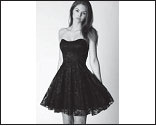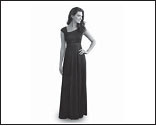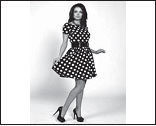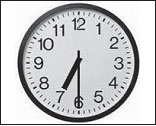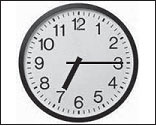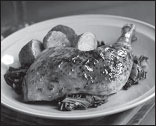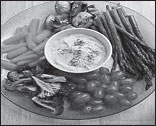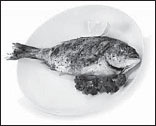ЗНО основна сесія 2019
Task 1. Listening
Listen to the speakers. For questions (1–6) choose the correct answer (A, B or C). Write your answers on the separate answer sheet. You will listen to each recording twice.
1. What dress is the speaker looking for?
|
|
|
|
| A | B | C |
2. When would the man like to be woken up?
|
|
|
|
| A |
B |
C |
3. What kind of food CAN’T be served to the traveller?
|
|
|
|
| A | B | C |
4. What does the speaker enjoy about his new place?
A nature
B neighbours
C houses
5. What did the fashionable stylist buy for her daughter in Tokyo?
A girlie clothes
B stylish tops
C great footwear
6. Why does the man feel bad?
A He has severe food poisoning.
B He has a catching illness.
C He is under considerable stress.
Task 2. Listening
Listen to the text. For statements (7–11) choose T if the statement is true according to the text, F if it is false. Write your answers on the separate answer sheet. You will listen to the text twice.
| - | T | F |
| 7. The speaker has taken up numerous hobbies. | ||
| 8. The speaker started making clothes when she was a child. | ||
| 9. The speaker’s friends are passionate readers of her fashion blog. | ||
| 10. The speaker thinks fashion is a rather expensive hobby. | ||
| 11. The speaker hopes to build her career in fashion business. |
Task 3. Listening
Listen to the text. For questions (12–16) choose the correct answer (A, B or C). Write your answers on the separate answer sheet. You will listen to the text twice.
12. Why did the head teacher introduce changes in the timetable?
A He acted according to the results of a study.
B He accepted the suggestion of the teenagers’ parents.
C He followed the practice of Oxford University.
13. What does a “flexible day” mean for these teenage students?
A They have classes of diRerent length.
B They come to school later three days a week.
C They are free to choose time for work experience.
14. Why do the students start school early on Friday?
A The teachers refuse to work overtime.
B School closes earlier before the weekend.
C The students have decided it themselves.
15. What has changed since the introduction of a “flexible day”?
A The students miss fewer classes.
B The teenagers have stopped fighting.
C The kids spend more time with their parents.
16. Who was against the experiment?
A local mass media
B teachers from other colleges
C the teenagers’ parents
Task 4. Reading
Read the texts below. Match choices (A–H) to (17–21). There are three choices you do not need to use. Write your answers on the separate answer sheet.
|
|
|
|
|
|
|
|
- |
Which of the advertisements deals with?
A health care
B housework assistance
C domestic IT support
D a family journey
E car purchasing
F animal keeping
G an educational vacation
H an art competition
Task 5. Reading
Read the text below. For questions (22–26) choose the correct answer (A, B, C or D). Write your answers on the separate answer sheet.
Unidentified Farming Object
One night last summer, while my husband, Earl, watched television in the family room, I relaxed and read in our bedroom. It was another nice, peaceful night in our quiet rural neighbourhood. It was about 10 p.m., when Earl burst into the bedroom shouting, “Get up! There’s something in the pasture – it looks like a UFO! It’s all covered in lights and is heading straight for the house!”
I felt my heart pounding against my chest as I jumped up, grabbed my housecoat and shoes, and ran outside with Earl to face whatever crisis was happening out there in the dark. And there it was, speeding directly toward us: an enormous object with light radiating all around it. The light was so blinding we couldn’t actually see the thing itself. For a second, I wondered if it really was a UFO. What else could it be?
Whatever it was, it was scary, coming out of nowhere, heading toward us at a high speed, lights blazing in the country darkness. But right before it reached the pasture fence, it made a fast turn. Without the lights shining directly in our eyes, we could see that it was a big high- powered tractor mower, lit up like Times Square on wheels.
That’s when we remembered that, several weeks earlier, we’d asked a neighbour if he knew anyone who could mow our pasture. He said he knew a fellow who planned to mow his hay nearby and might do ours at the same time, but he didn’t know when. After some time, we learnt that the tractor driver was in the hospital with back trouble. But as the weeks went by, we forgot the whole matter.
Apparently, the fellow had either recovered or had hired someone to mow his hay. Whoever it was, he or she decided to finish oR the day by driving in through our open gate and doing our pasture after dark.
We were extremely relieved to see that our unexpected meeting had nothing to do with aliens determined to start their Earth invasion in our pasture. By the time our heart rates had settled down to normal, we burst into laughter.
Who says we don’t have excitement out in the country?
22. What happened to Earl and Shirley one night?
A They found a spaceship in their garden.
B They noticed a bright light at midnight.
C They heard a loud noise in the yard.
D They saw a frightening object nearby.
23. How did Shirley react to Earl’s words?
A She had a heart attack.
B She rushed out barefoot.
C She followed her husband.
D She hid in the house.
24. Which of the following is NOT TRUE about the tractor?
A It looked horrible.
B It moved very quickly.
C It made a terrible noise.
D It illuminated the area.
25. Why were Shirley and Earl surprised to see the tractor?
A They had forgotten about their plans.
B They were already sleeping peacefully.
C They had harvested their hay themselves.
D They knew about the neighbour’s illness.
26. What can be inferred from the passage about Shirley and Earl?
A They are amused by the incident.
B They are interested in aliens and UFOs.
C They feel bored living in the country.
D They are adventurous people.
Task 6. Reading
Read the texts below. Match choices (A–H) to (27–32). There are two choices you do not need to use. Write your answers on the separate answer sheet.
New Year Traditions
27.
In the Czech Republic, fireworks light up the sky. In Prague, visitors can watch fantastic fireworks on the world-famous Charles Bridge after the clock strikes midnight. All across the country, people gather in pubs, clubs, and city squares to celebrate New Year.
28.
In Ecuador, thousands of life-size dolls representing misfortunes from the past year are burnt in the streets. They are made from newspapers and pieces of wood, and at midnight everyone gathers outside their homes to burn the dolls together. Another interesting feature is that some men dress like women to ask for beer money. Kids will dress up too and ask for candy.
29.
The Chinese Lunar New Year, or the “Spring Festival”, does not happen until late January or early February. Traditions vary across China, but many include cleaning. The grounds, the walls, and every corner of the house need to be cleaned to drive misfortunes away. Then the Chinese buy presents for loved ones, and children receive money in red paper envelopes.
30.
On New Year’s Eve in Japan, Buddhist temples ring their bells 108 times to welcome Toshigami, the New Year’s God. The Japanese also send thank-you cards called “nengajo” that wish a Happy New Year and give thanks to friends and relatives.
31.
Some people in Estonia believe that they should eat seven, nine, or twelve meals on New Year’s Eve. It is believed that the person gains more strength with each meal eaten. You don’t have to eat the entire meal, however – part of the meal is left unfinished for the spirits of ancestors who visit the house on New Year’s Eve.
32.
Single women of Ireland place mistletoe under their pillows on New Year’s night in the hope that it will bring them better luck and a future husband. Also, according to Irish superstition, be careful of who enters your home after the 31st of December – if the visitor is a tall, dark handsome man, a new year will bring good fortune. If it’s a red-headed woman, she will bring a lot of trouble.
Where do people... ?
A start celebrating with ritual sounds
B put flowers on the front door
C tidy up their homes to get rid of bad luck
D decorate cakes with candy roses
E put paper figures on fire
F go to public places to party together
G associate bad luck with hair colour
H have a fixed number of dishes
Task 7. Reading
Read the text below. Choose from (A–H) the one which best fits each space (33–38). There are two choices you do not need to use. Write your answers on the separate answer sheet.
A decade ago, Fabrice Schnuller was an engineer (33) _________ . In 2007, he went on a sailing trip to the island of Mauritius. One day, when his boat approached the coast, giant towers of steam began (34) _________ . Curious as to the source of this strange ocean phenomenon, Schnuller grabbed his snorkelling equipment and a camera, and jumped in. Diving down beneath the ship, Schnuller felt his ears were bombarded by what sounded like underwater explosions, (35) _________ the deeper he went. At first he feared the boat had suRered a mechanical failure. But as he circled around, he began to sense that he was not alone. Glancing downwards, Schnuller froze. Out of the darkness, a series of giant dark monolithic shapes were heading directly towards him. It was a group of whales speeding towards the surface. As they approached, the sounds grew louder and louder until they penetrated his flesh like an X-ray. Schnuller felt the warm vibrations (36) _________ from every angle. The whales surrounded him, staring with large, unblinking eyes. At more than 60 feet in length and weighing approximately 125,000 pounds, they made him feel small. But rather than (37) _________ in one gulp, the whales appeared to be deeply intrigued. After scanning him, the rhythm structure of their sounds began to change. Schnuller later realised that these were the patterns that we believe whales use to communicate and send information. The whales appeared to be speaking to him. They stayed for two hours, circling, staring and showering him with bursts of sound, before (38) _________ into the deep.
A swallowing the helpless Schnuller
B growing louder
C disappearing once more
D free-diving with them
E passing through his skeleton
F understanding their connection with the sea
G exploding out of the water
H working on systems for tracking sharks
Task 8. USE OF ENGLISH
Read the texts below. For questions (39–48) choose the correct answer (A, B, C or D). Write your answers on the separate answer sheet.
The History of the T-Shirt
At the beginning of the twentieth century, the T-Shirt quickly became an American favourite. Now, a century later, the T-Shirt (39) _________
as popular as ever.
The American T-Shirt began (40) _________ WWI when American armed forces noticed European soldiers wearing a lightweight cotton undershirt on the hot European summer days. Compared to the wool uniforms that the American soldiers wore, these undershirts were cooler and more comfortable and they quickly caught on with the Americans. Due to their simple (41) _________ , these shirts became known in the USA as “T-Shirts”.
In the 60s people began to tie dye and screenprint the basic cotton T-Shirt making it an
even bigger commercial (42) _________
. Advances in printing and dying allowed more
variety and the Tank Top, Muscle Shirt, Scoop Neck, V-Neck, and many other variations of the T-Shirt
(43) _________ into fashion.
| # | A | B | C | D |
| 39 | remains | goes | continues | leaves |
| 40 | at | оn | during | for |
| 41 | colour | design | fashion | |
| 42 | success | profit | income | progress |
| 43 | went | came | moved | entered |
Bach, Beatles and …Maths?
From the rich complexity of the Bach fugues to the catchy songs of the Beatles, music and mathematics overlap in all kinds of interesting (44) _________ .
Would you believe that research has shown that certain (45) _________ of music end up being more popular and mainstream (46) _________ their “mathematical” structure?
The link between the physical practice of music and strong mathematical (47) _________ are demonstrated in various studies. They show that kids who play a musical instrument can (48) _________ more complex arithmetical operations than those who do not play an instrument.
| # | A | B | C | D |
| 44 | means | items | ways | methods |
| 45 | notes | pieces | details | tones |
| 46 | except for | along with | due to | apart from |
| 47 | abilities | opportunities | properties | features |
| 48 | count | enumerate | achieve | perform |
Task 9. USE OF ENGLISH
Read the texts below. For questions (49–58) choose the correct answer (A, B, C or D). Write your answers on the separate answer sheet.
This Smartphone Case Doubles as an Espresso Machine
Mokase is the world’s first smartphone case that also (49) _________ users a warm shot of espresso whenever they want. It’s aimed at people who are always on the go, whose lifestyle prevents (50) _________ from stopping by a coRee shop for a dose of caReine. Smart K, the Italian company that came up with the concept for Mokase, claims that they were looking for a way to make coRee available (51) _________ . Pairing an Espresso Machine with a smartphone just (52) _________ sense. “We thought, “how to make it always available? Why not (53) _________ it to a gadget that is already a piece of our lifetime?” The smartphone is the answer,” Smart K stated in a press release.
| # | A | B | C | D |
| 49 | serve | is served | serves | are serving |
| 50 | themselves | their | them | theirs |
| 51 | nowhere | anywhere | somewhere | elsewhere |
| 52 | had made | make | made | making |
| 53 | join | to join | joined | joins |
The Cabbies are Smarter than Google Maps
London has the most informed cab drivers in the world – and they’ve got the diplomas to prove it. To become a certified taxi operator in London, a driver must first pass “the Knowledge,” an extraordinarily difficult exam that (54) detailed recall of 25,000 streets and locations within a (55) _________ radius of London’s Charing Cross railway station. Plus, they have to be fluent in English. Most drivers take three years (56) _________ the Knowledge, and many practice (57) _________ tracing the routes on a bicycle. Drivers must know their directions backwards and forwards, which is a (58) _________ task in the maze of London’s one-way streets and blocked-oR pedestrian zones.
| A | B | C | D | |
| 54 | involved | involves | involving | to involve |
| 55 | six-mile | six-mile’s | six-miles’ | six-miles |
| 56 | have mastered | be mastering | to master | master |
| 57 | over | for | with | by |
| 58 | complicating | complicated | complicate | complication |
Writing
59. You’ve read a book about a famous person. You’ve decided to share your impressions with a pen-friend. Write a letter to your English pen-friend in which you tell him/her
- who the book is about and what this person is famous for
- what area of activity you’d like to achieve success in and why
- what personal characteristics one should have to succeed in life.
Write a letter of at least 100 words. Do not write your own name, any dates, addresses or other personal information. Start your letter in an appropriate way.
_________________________________________________________________________
_________________________________________________________________________
_________________________________________________________________________
_________________________________________________________________________
_________________________________________________________________________
_________________________________________________________________________
_________________________________________________________________________
_________________________________________________________________________
_________________________________________________________________________
_________________________________________________________________________
_________________________________________________________________________
_________________________________________________________________________
_________________________________________________________________________
_________________________________________________________________________
_________________________________________________________________________
_________________________________________________________________________
_________________________________________________________________________
_________________________________________________________________________
_________________________________________________________________________
_________________________________________________________________________
_________________________________________________________________________
_________________________________________________________________________
_________________________________________________________________________
_________________________________________________________________________
_________________________________________________________________________
_________________________________________________________________________
_________________________________________________________________________
_________________________________________________________________________
 uk
uk en
en